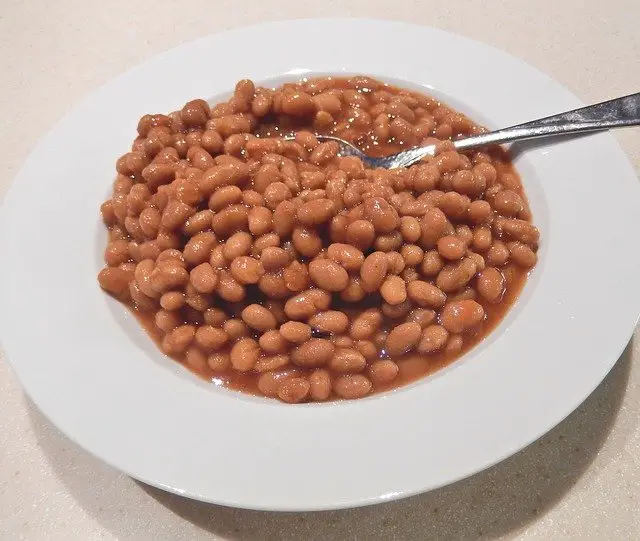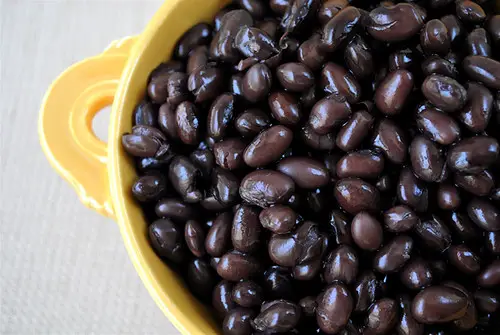
Canned beans are one of my favourite ingredients to cook with. Sometimes I’ll happily add three full cans of beans to a pot of bean soup, or use a whole tin of baked beans for our family dinner. But other times, I only want to use a couple of tablespoons of beans, so I always put the rest back in the fridge for later. If you like to do the same, read on to find out how long canned beans last in the fridge once they’ve been opened.
Once a can of beans has been opened, you should use up the remaining beans within 3 to 4 days. They should be stored in an airtight container in the fridge. If they’re not stored correctly, or are kept for too long, the risk of food poisoning increases.
There are plenty of ways to maximise the amount of time you can keep leftover canned beans – here are some of my best tips for storing canned beans once they’ve been opened.
All of the information in this article can apply both to plain canned beans (e.g. tins of black beans, kidney beans, etc.), and tins of baked beans in tomato sauce (the kind of thing we Brits eat on toast!). Canned chickpeas and canned lentils can also be treated in the same way. Whatever your favourite legume, there’s a way to store it safely!
How long to store leftover tinned beans
As a general rule, canned beans can be stored for about 3 to 4 days once they’ve been opened. This same rule applies to pretty much all cooked leftovers, according to the USDA.
Of course, this is a conservative estimate. Most of the time, you’ll be able to get away with stretching this by an extra day or so without too much worry.
However, the longer you store your leftover food, the higher the risk of food poisoning, so if you do choose to eat your leftover canned beans after storing them for more than the recommended 3-4 days, do so at your own risk.

How to safely store leftover canned beans
Here’s a simple method for safely storing your leftover beans. These tips apply to beans that are being stored straight from the can, as well as to leftover beans that you’ve already cooked.
- If your leftover beans are hot, make sure you cool them quickly, so they don’t sit in the ‘danger zone’ temperature (between 8°C and 60°C, or 45°F and 140°F) for too long. This is the temperature range at which bacteria grows most quickly, so you don’t want any food to sit at this temperature for an extended period of time. If you need to speed up the cooling process, remove the beans from the hot pan or bowl, and spread them out into a thin layer on a plate.
- As soon as they’ve cooled, use a clean spoon to transfer your beans into your storage container. Don’t use the same spoon that you’ve used for eating, or you’ll be introducing bacteria from your mouth into the leftover beans, which could cause them to spoil more quickly.
- Your storage container should be airtight, and made from plastic or glass – click here* to see some great options on Amazon. Don’t use an uncovered bowl, or any other unsealed container. If leftover food is open to the air, bacteria grows more quickly, and the food can also become dry and discoloured.
- Place the sealed container in the fridge, and store it for up to 3-4 days.
Can you store leftover beans in the can?
It can be really tempting to just stick the whole can of beans in the fridge once you’ve scooped out the ones you need. But this isn’t particularly safe – you shouldn’t place the whole can of beans in the fridge once the can has been opened.
This is partly because the outside of a tin can be pretty dirty. There’s a long supply chain to get the can of beans from the factory to your kitchen cupboard, including various warehouses, truck journeys, and who knows how many people’s hands. There could be all sorts of bacteria on the outside of a tin can.
If you place an opened tin can in your fridge, the bacteria from the outside of the can is able to contaminate the beans inside. It could even spread to contaminate other foods in your fridge.
There could also be issues with the metal from the can beginning to oxidise once it has been opened, which could affect the quality of the food inside. It can give the food a strange, metallic taste.
Instead, you must transfer the can’s contents into a clean storage container, such as a plastic or glass tub, with an airtight lid. These ones on Amazon (US / UK) are perfect.

How to tell if leftover beans have spoiled
If you keep your leftover beans in the fridge for too long, they will start to spoil. It won’t always be obvious at first glance whether or not your beans are okay to eat, so test them in three stages:
- Look at the beans closely. Check if there is any visible mould. If the beans have spoiled, they may also have become a bit gooey, with a sludgy white liquid surrounding them. If they don’t look right, it’s best to dispose of them.
- If they pass the visual test, give your beans a good sniff. If they’re spoiled, they will probably smell unpleasant. If they don’t smell very appetising, get rid of them.
- Finally, if your leftover beans have passed both the visual test and the smell test, give them a little taste – just one bean to begin with. If it tastes fine, the beans are probably okay to eat.
If your leftover beans spoil, they won’t taste good, and could give you a severe case of food poisoning. This is why it’s so important to store your canned beans properly, and to dispose of them after the recommended 3-5 days.

Can you freeze leftover canned beans?
Absolutely! Canned beans can be frozen instead of stored in the fridge, if you’re not planning to use them up within the recommended 3-4 days.
The storage process is pretty much the same as if you were to keep them in the fridge: Transfer the leftover beans to an airtight plastic or glass container, and place straight in the freezer.
Your beans will be best eaten within a month or two, but there’s no reason you couldn’t eat them after this time. A lot of frozen foods can be kept almost indefinitely. Their quality will gradually deteriorate over time, but they should still be safe to eat.
If you are planning to keep your beans in the freezer for a particularly long time, their texture may begin to change, and they may be a bit softer and mushier when thawed. They’ll still be fine to eat, but you might want to save them for adding to soups and stews, where they can be cooked thoroughly. I’d probably avoid using them for something like a salad, where the altered texture will be more obvious.
Once you’ve thawed your frozen beans, use them within 3-4 days.
